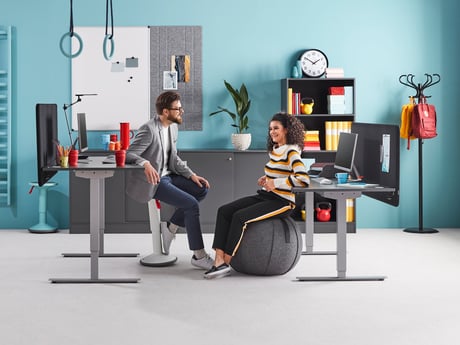How your workplace can make your staff healthier

Physical health has a major impact on emotional wellbeing and the ability to perform well at work. The workplace has an important role to play in creating a healthy work environment that encourages more active lifestyles amongst employees. As businesses come to understand the impact wellbeing has on motivation, productivity, creativity and job satisfaction, we look at how to make simple changes to the workplace to improve employee health.
What changes can you make to the work environment to improve employee health and wellbeing?
Active office furniture
Swap your old desks for sit-stand desks that make it possible for staff to switch from a seated position to a standing one at the push of a button. Active sitting chairs are another smart choice, allowing employees to keep moving even when they do need to sit down. Sit-stand furniture encourages greater levels of activity, helping to reduce the risk of heart disease, type 2 diabetes and obesity as well as musculoskeletal problems, such as back and neck pain. Standing at work has also been linked to increased productivity, greater levels of creativity and improved mood.
Healthy eating options in the company canteen
If freshly-prepared, healthy food options are readily available on site, employees are more likely to make good choices about eating. Lunch breaks are all about convenience so if the nearest place to grab a bite to eat is a fast food restaurant or the local garage for a takeaway sandwich, then that’s where many of your staff will go. Get rid of the vending machines, hire a catering company with a good reputation and offer plenty of choice at reasonable prices so that employees choose to eat in the company canteen instead. An added bonus is that staff get together in a more social setting, which is great for company morale. Make sure you have plenty of canteen tables and chairs so there isn’t a scramble for seats!
Walking or standing meetings
A walking meeting is exactly what it sounds like: a meeting that takes place during a walk instead of in the office. Walking meetings work best with two or three people and are most suited to general discussions rather than planning meetings that might need notes to be taken, for example. Remember to let people know in advance that it will be a walking meeting so they can come prepared!
Alternatively, why not try a standing meeting? With a sit-stand meeting table, you can easily hold productive stand-up meetings, of which there are several benefits. Standing helps keep meetings short and to the point¹; it has also been shown to encourage collaboration and improve engagement². Moreover, sitting for long periods of time places strain on the body. Standing meeting tables can help provide relief to the back, neck and shoulders of meeting participants. When people are comfortable, they concentrate better, which boosts productivity: it’s a win-win.
Centrally located stairways
Choosing to take the stairs is a really simple way for staff to get some exercise in their workday. Easy-to-access stairways can make a big difference. If the lift is the first thing people see, and the stairs are hidden off to one side of the lobby or only used as a fire exit, then it goes without saying that most people will take the lift. However, if the stairs are centrally located and part of the main office design, then taking the stairs will become the norm – at least when only one or two flights are involved!
Organised fitness activities
Organise physical activities for lunch breaks or after hours where employees can join in for some light exercise. This could range from lunchtime walks to morning yoga classes to an after-work running club. It could mean arranging for fitness instructors to come into the office to lead classes or it could be as simple as setting up a forum to get likeminded colleagues together – after all, people are more likely to go for a walk on their break if they’ve arranged to go with someone!
Bicycle racks
Encourage staff to cycle to work by providing plenty of secure bike storage. Bikes are expensive and if staff are worried about not having somewhere safe to leave theirs, it could discourage them from cycling at all. Think carefully about how many bicycle spaces you should provide and how to maximise the space available by choosing the right cycle racks for your workplace, bearing in mind that more people are likely to cycle in the summer! You should also make sure employees are aware of the government’s Cycle to Work scheme, which makes cycling more affordable and offsets the upfront costs of a bike.
The benefits of a healthy workplace shouldn’t be ignored. Feeling fit and healthy is good for your employees’ mental health, which will be reflected in their work. Staying active at work and eating right also gives employees more energy, which improves productivity. Finally, the knowledge that the company cares about their wellbeing boosts job satisfaction and employee retention.
² Lehman, S. (2014) "Standing meetings may improve group productivity" Reuters [online] available from: http://www.reuters.com/article/us-psychology-group-meetings-productivit-idUSKBN0EV29V20140620 [accessed July 2021]



